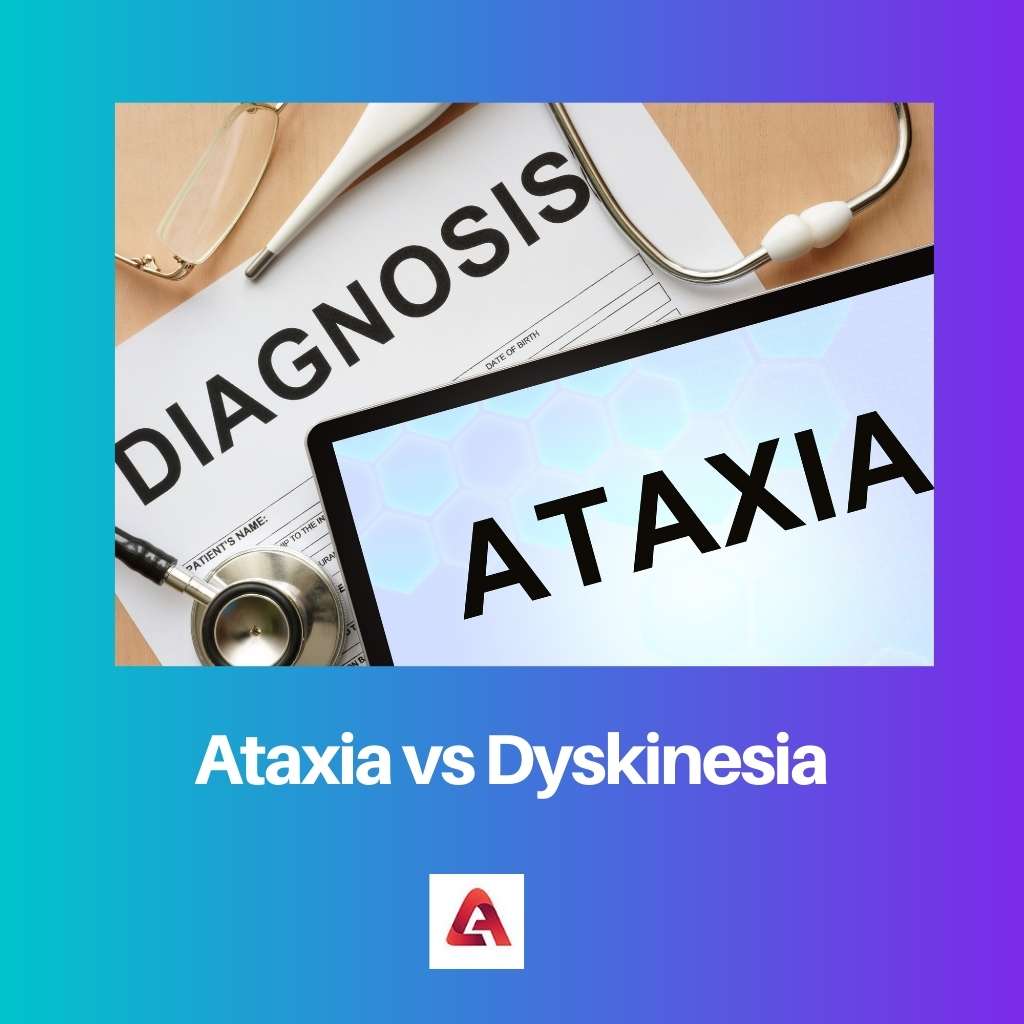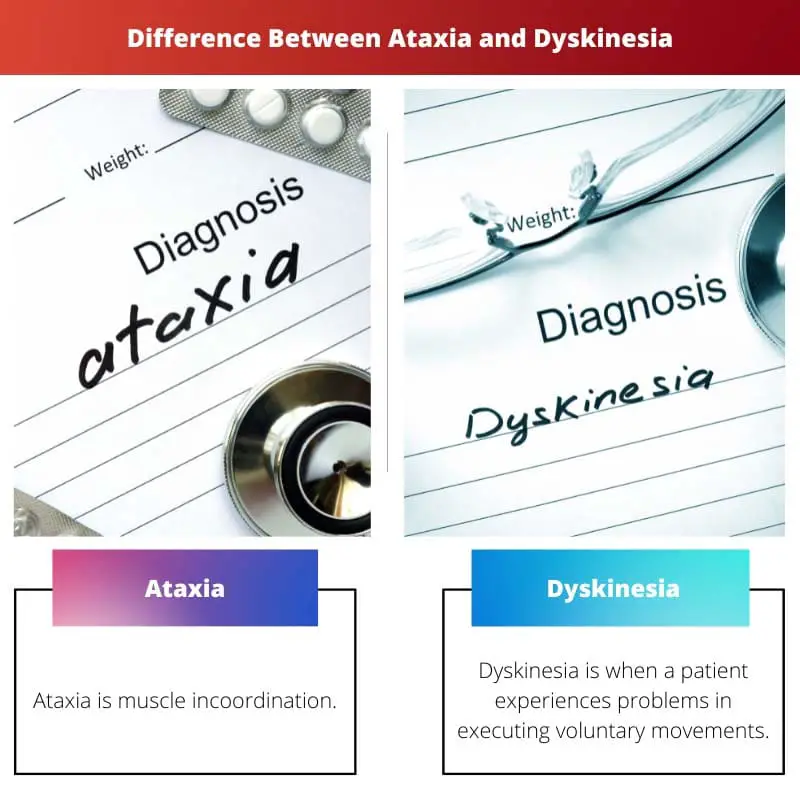Ataxia and dyskinesia are two completely separate medical conditions that patients frequently mix and match.
Both of these medical ailments are movement disorders that involve conditions involving muscular movements, but the distinction between these terminologies is important for everyone to understand.
Even if there is muscle involvement, the symptoms are completely different.
Key Takeaways
- Ataxia is a neurological disorder causing a lack of muscle control, resulting in uncoordinated movement and balance issues.
- Dyskinesia refers to involuntary muscle movements, such as spasms, tics, or cramps, without any underlying coordination problems.
- Ataxia affects coordination and balance, while dyskinesia causes abnormal, uncontrollable movements.
Ataxia vs Dyskinesia
Ataxia is a type of movement disorder caused by a damage to the spinal cord or other nerves. It affects parts of the nervous system that control movement and balance and can also cause vision and heart issues. Dyskinesia is a movement issue that causes uncontrolled and involuntary muscle movements.

Ataxia refers to a group of neurological illnesses that impair coordination and movement. Ataxia patients frequently struggle with coordination, balance, communication, and swallowing.
Ataxia is associated with damage to a portion of the brain that controls movement. Ataxia can occur at any age.
Dyskinesia occurs when your body behaves in ways that you are unable to manage. It can afflict only one part of your body, such as your arm or head. It can also impact your full body.
Dyskinesia can occur in persons with Parkinson’s disease as a secondary effect of long-term levodopa medication or treatment. Dyskinesia can arise in illnesses other than Parkinson’s, such as movement problems.
Comparison Table
| Parameters of Comparison | Ataxia | Dyskinesia |
|---|---|---|
| Definition | Ataxia is muscle incoordination. | Dyskinesia is when a patient experiences problems in executing voluntary movements. |
| Symptoms | Effect on balance and coordination, fine motor incoordination, speech and swallow problems, and others. | Wriggling, twitching, fidgeting, and others. |
| Causes | Ataxia is a symptom of another health condition. | Dyskinesia is commonly caused by a medical treatment like levodopa in Parkinson’s disease. |
| Types | Ataxia-telangiectasia, Friedreich’s ataxia, multiple system atrophy, spinocerebellar ataxia, and episodic ataxia. | Myoclonus dyskinesias, athetosis, chorea, tardive, and levodopa-induced or Parkinson’s dyskinesia. |
| Diagnosis | Blood tests, MRI, or Genetic testing. | Blood tests, MRI, or CT scan. |
What is Ataxia?
To put the term ‘Ataxia’ into clear words, it is a ‘muscle incoordination.’ Ataxia is caused by injury to the spinal cord and perhaps other nerves in the body. Ataxia is a medical term that refers to a ‘group’ of neurological conditions.
Surprisingly, there is no cure for ataxia, but the symptoms can be alleviated. Ataxia occurs when the cerebellum, a component of the brain, is damaged.
Individuals who suffer from this condition will experience a variety of symptoms, the most prominent of which will be difficult with coordination, speech, balance, and swallowing.
These tasks will be complicated for them. The cerebellum coordinates movement, and when it is affected, people experience these symptoms. The condition Ataxia can affect people of all ages.
And the condition is progressive, which means that it worsens over time. If the symptoms are not addressed promptly, they may increase.
Ataxia is a relatively uncommon disorder, and if a person has it, it indicates that they have suffered significant damage. However, there are various forms of Ataxia.
Not all Ataxias are the same; they have all termed Ataxia but are classified differently. Though ataxia occurs when the cerebellum is damaged, there are various other reasons, such as severe injury or infection.
Ataxia causes are further classified into three types: genetic ataxia, acquired ataxia, and idiopathic ataxia.
What is Dyskinesia?
To comprehend Dyskinesia is a simple term that describes when a person’s body moves in ways that they are unable to regulate.
Dyskinesia does not have a specific field of impact, which means it might affect one or more parts of the body, such as the arm or head.
Dyskinesia patients range in severity from mild to severe. Dyskinesia can occur in persons with Parkinson’s disease as a secondary effect of long-term levodopa medication.
Dyskinesia symptoms vary from person to person. The majority of people have a variety of symptoms. Some people may experience fidgeting symptoms, while others may experience wriggling.
Dyskinesia is sometimes linked with tremor, however is not quite the same as the tremor that occurs frequently in Parkinson’s disease. Depending on the severity of the patient’s dyskinesia, it can be managed.
When Levodopa raises dopamine levels in the brain.
However, when you receive levodopa, your dopamine levels increase and then decrease as the levodopa wears off. And to better understand it, it is believed that changes in dopamine levels are the source of dyskinesia’s uncontrollable motions.
Regardless, the treatment will be carefully addressed, and the doses may vary.
Main Differences Between Ataxia and Dyskinesia
- Ataxia is a muscle incoordination whereas on the other hand Dyskinesia is an issue when a patient experiences problems in body movements without will.
- Ataxia is actually a cause of other health condition like damage to the cerebellum. Dyskinesia on the hand is mainly caused by medical treatment like levodopa.
- There are around 5 types of Ataxia and these types depends upon the kind of issue. On the other hand, Dyskinesia also has multiple types and some of the examples are tardive, levodopa-induced etc.
- Ataxia can be diagnosed by MRI, blood tests and even genetic testing. Whereas Dyskinesia can be diagnosed through MRI, CT scan or blood tests.
- The symptoms of Ataxia are swallowing issue, speech issue, etc. The symptoms of Dyskinesia is wriggling, fidgeting and others.

- https://movementdisorders.onlinelibrary.wiley.com/doi/abs/10.1002/mds.870070202
- https://academic.oup.com/ptj/article-abstract/77/6/672/2633166
- https://www.nature.com/articles/nrn2471
